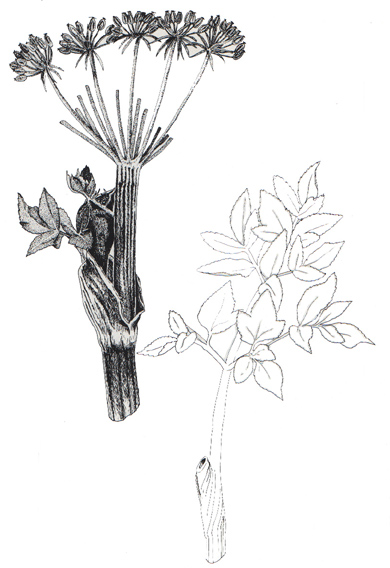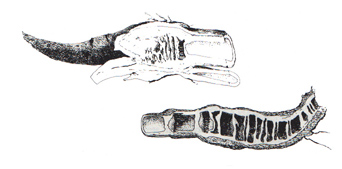

Angelica
Angelica species
(Umbelliferae)
Description:
The stems of these plants are 3 to 4 1/2 feet (1 to 1.5
meters) tall, erect, hollow, and coarse, with many oil tubes. The compound leaves
form groups of three leaflets; leaf stalks have inflated bases that sheath the
stem. Leaflets are ovate, toothed and not hairy. The inflorescence, an umbel,
has no involucre. The flowers are greenish white.
The ribbed fruits of Angelica genuflexa have wings and the upper leaves are reflexed. On the other Alaskan species of Angelica, A. lucida, the ribbed fruits are not winged; the upper leaves are not reflexed.
Distribution:
Angelica lucida grows in coastal Alaska and the Alaska
Range, eastern Siberia, and Canada. Angelica genuflexa is less widely
distributed, occurring in the coastal zone of southeastern and central Alaska
and on the Aleutians. Other species of Angelica appear in China and Europe.
Constituents:
Information is available only for A. archangelica, a
European species. A volatile oil, angelic acid, and resin are listed in The
Merck Index. Taskinen and Nykanen describe a large number
of constituents including g-phellandrene, borneol, pentadecanolide, 2-methyl
butyric acid, and monoterpene hydrocarbons. The musklike odor of angelica root
oil is attributed to the lactone of hydroxypentadecanoic acid.
Medicinal uses:
Tanainas use A. lucida root as a medicine on the
outside of the body--for aches, pains, sores, cuts, blood poisoning, and any
kind of infection. They first cut up the root and mash it, then boil the mashed
root or soak it in hot water. Then they place it on the place needing treatment.
(Karl) Older Eskimos would slice the roots into two parts, heat the halves and
place them over the area of the body that hurt, even for deep pain. (Smith)
One of the few Alaskan plant medicinal use citations in Hulten concerns A.
lucida: The Siberian Eskimos inhaled the fumes of the roasted root as a
seasickness remedy.
Angelica leaves were used as a poultice by the island and Iliamna Tanainas. European A. archangelica virtues were praised in old writings. The plant name itself testifies to the great antiquity of a belief in its merits for protecting against contagion, for purifying the blood, and for curing every conceivable malady. It was held a sovereign remedy for poisoning, indigestion, general debility, agues, and all infectious maladies. (Grieve, Simmonite-Culpeper) Its therapeutic actions are carminative, diaphoretic, diuretic (Merck), expectorant, emenagogue (Grieve), stimulant, stomachic, tonic. An infusion from the root is used to relieve flatulence.
A sample of A. sinensis root slices purchased in China seemed to me to have an odor very similar to the Alaskan A. lucida. Another Chinese Angelica is described by Hong-Yen Hsu. This plant, "Angelicae Dahuricae Radix," was first recorded as a "drug" in one of the oldest Chinese Books, The Classic on Mountains and Seas (400 B.C.). Hsu says it can be used to treat the common cold, migraine, dizziness, neuralgia and excessive perspiration. Jackson and Teague say the Chinese herb dong quai, obtainable in powdered, sliced or whole chunk form in many herb stores, is Angelica, and is a female tonic similar to the tonic for men, ginseng. (Devil's club is known as Alaska ginseng, since it is in the same family.) A friend has reported that for the first time in her life, after drinking dong quai tea daily for about one month, her menstrual period has become regular and pain-free. Angelicapolymorpha var. sinensis extracts have long been used in Chinese medicine to stimulate uterine contractions as a post-partum aid.
The juice of Angelicais used in both Eurasia and America to relieve pain in a decayed tooth, and it is one of the many herbs considered a tonic to improve well-being and mental harmony. (Lewis and Elvin-Lewis)
Other uses:
The ripe fruit of A. archangelica is used in teas
throughout the world. Its root is used to flavor cigarette tobacco. Angelica
root is grown commercially; its derivatives (the essential oil, extracts, distillates)
find extensive use in flavor formulations for alcoholic beverages such as vermouths,
bitters, benedictine and chartreuse-type liqueurs. (Taskinen and Nykanen)
Although angelica is included in the list of higher plants that provoke photodermatitis in man, it is one of the many herbs used for perfume and for scenting creams, salves, soaps, oils and shampoos.
I have had difficulty in getting angelica seeds purchased from an herb company to germinate, as they evidently require light (seeds usually require dark to germinate).
Warning:
There is a tendency for angelica to increase sugar in
the urine, so it would be contraindicated in persons with diabetes.
Before attempting to gather angelica, you should be sure that you know how to distinguish it from the poisonous water hemlock, Cicuta.They both have white umbels and some of the species have similarly shaped leaves. The Cicuta root has large transverse chambers separated by shelves (see illustration below).
| Angelica |  |
Water hemlock |
Copyright © 1987 by Eleanor G. Viereck